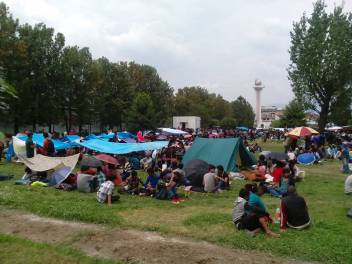 80 years after the great earthquake in Nepal, 8 million Nepalis were again hit by another major earthquake measuring 7.8 on the Richter scale.
80 years after the great earthquake in Nepal, 8 million Nepalis were again hit by another major earthquake measuring 7.8 on the Richter scale.
The powerful earthquake hit Nepal on 25 April – its epicentre 50 miles (80km) east of the capital, Kathmandu. The following day, a second earthquake measuring 6.7 on the Richter scale further exacerbated the situation. The last earthquake of a similar magnitude was in 1934 and killed over 8,500 people.
Sleeping outside
As of today, casualties are estimated at over 6,200 and the number of injured at 14,000. The death toll is expected to increase as more information becomes available.
Reports estimate that 130,033 houses were destroyed and 85,856 houses were partially damaged, across the 39 affected districts, out of 75 in total. The most affected districts include, Sindhupalchowk, Kathmandu, Nuwakot, Dhading, Bhaktapur, Lalitpur, Kavrepalanchowk, Gorkha and Rasuwa.
Tremors and strong aftershocks forced many people in the affected areas to sleep outside, while rainfall in the past few days has further increased their suffering.
Aid starting to arrive
16 temporary camps have been set up in the Kathmandu Valley. People are also taking shelter at local schools, temples and private land. Hospitals in the Kathmandu Valley area are overcrowded. They are running out of space for storing the dead and running low on emergency supplies. Diarrhoea and flu is already becoming a problem in some affected areas.
While search and rescue efforts are winding down, identifying missing people and reuniting families have become key challenges. Humanitarian agencies have started distributing shelter kits, hygiene kits and other emergency items including tents, blankets, health kits and telecommunications equipment.
Needs are expected to increase as more information becomes available through clusters and needs assessments in affected districts. Efforts are continuously being made to reach out to those who haven’t been reached yet.
How we’re helping
Several humanitarian organisations are providing immediate support to the victims of all age groups, covering the general needs of older people as well.
Our emergency team has arrived in Kathmandu and is working with us and local partners. Together we will be carrying out rapid assessments and conducting distributions and cash transfers.
We are also working to identify older people who are most in need of cash transfers and to ascertain what they need in terms of food, shelter, healthcare and water and sanitation among other things.
How you can help
To support older people affected by the Nepal earthquake:
